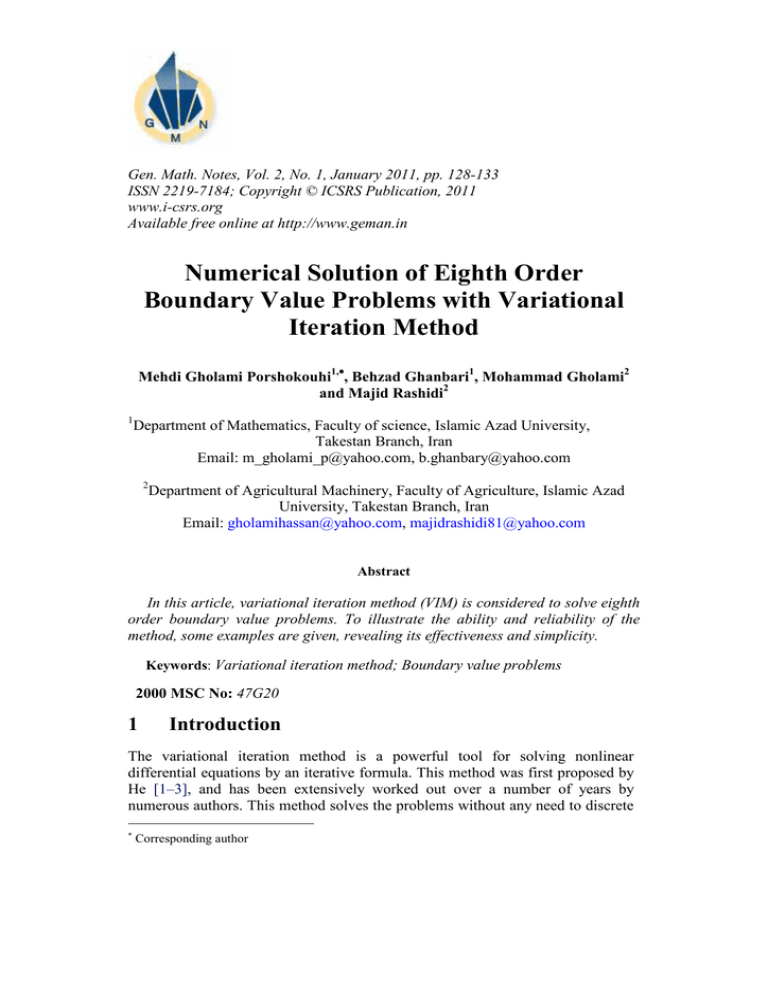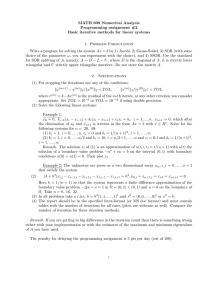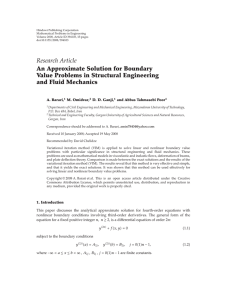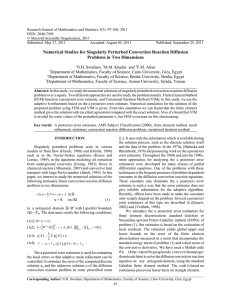Gen. Math. Notes, Vol. 2, No. 1, January 2011, pp.... ISSN 2219-7184; Copyright © ICSRS Publication, 2011
advertisement

Gen. Math. Notes, Vol. 2, No. 1, January 2011, pp. 128-133
ISSN 2219-7184; Copyright © ICSRS Publication, 2011
www.i-csrs.org
Available free online at http://www.geman.in
Numerical Solution of Eighth Order
Boundary Value Problems with Variational
Iteration Method
Mehdi Gholami Porshokouhi1,∗∗, Behzad Ghanbari1, Mohammad Gholami2
and Majid Rashidi2
1
Department of Mathematics, Faculty of science, Islamic Azad University,
Takestan Branch, Iran
Email: m_gholami_p@yahoo.com, b.ghanbary@yahoo.com
2
Department of Agricultural Machinery, Faculty of Agriculture, Islamic Azad
University, Takestan Branch, Iran
Email: gholamihassan@yahoo.com, majidrashidi81@yahoo.com
Abstract
In this article, variational iteration method (VIM) is considered to solve eighth
order boundary value problems. To illustrate the ability and reliability of the
method, some examples are given, revealing its effectiveness and simplicity.
Keywords: Variational iteration method; Boundary value problems
2000 MSC No: 47G20
1
Introduction
The variational iteration method is a powerful tool for solving nonlinear
differential equations by an iterative formula. This method was first proposed by
He [1–3], and has been extensively worked out over a number of years by
numerous authors. This method solves the problems without any need to discrete
∗
Corresponding author
129
Numerical solution of eighth order boundary value problems with
VIM
the variables. Therefore, there is no need to compute the round off errors and one
is not faced with necessity of large computer memory and time.
Consider the following boundary value problem
y8 ( x ) + f ( x ) y ( x ) = g ( x ) ,
y ( a ) = α0 ,
y ( b ) = α1 ,
y (1) ( a ) = γ 0 ,
y (1) ( b ) = γ 1 ,
y( 2) ( a ) = δ 0 ,
y ( 2 ) ( b ) = δ1 ,
y ( 3) ( a ) = η 0 ,
y ( 3) ( b ) = η1 ,
x ∈ [ a, b ] ,
(1)
Where α i , γ i , δ i and ηi ; i = 0,1 are finite real constants while the functions
f ( x ) and g ( x ) are continuous on [ a, b] .
To illustrate the method, consider the following general functional equation
( 2)
Lu (t ) + N (t ) = g (t ) ,
Where L is a linear operator, N is a non-linear operator and g (t ) is a known
analytical function. According to the variational iteration method, we can
construct the following correction functional
u n +1 (t ) = u n (t ) + ∫ λ (ξ ) {Lu n (ξ ) + Nu%n (ξ ) − g (ξ )} d ξ ,
t
0
( 3)
Where λ is a general Lagrange multiplier which can be identified optimally via
variational theory, u 0 is an initial approximation with possible unknowns, and
u%n is considered as restricted variation, i.e., δ u%n = 0 [4].
2
numerical examples
In this section, we present examples of eighth order boundary value problems
and results will be compared with the exact solutions.
Example1. Consider the following eighth order boundary value problems [5]:
(
)
y (8) ( x ) + x y ( x ) = − 48 + 15 x + x 3 e x , 0 < x < 1,
( 4)
Mehdi Gholami Porshokouhi et al
130
With the boundary conditions:
y ( 0 ) = 0,
y (1) = 0,
y ( ) ( 0 ) = 1,
y ( ) (1) = −e,
( 0 ) = 0,
3
y ( ) ( 0 ) = −3,
(1) = −4e,
3
y ( ) (1) = −9e,
1
y(
1
2)
y(
( 5)
2)
The analytical solution of the above problem is given by,
y ( x ) = x (1 − x ) e x .
(6)
In the view of the variational iteration method, we construct a correction
functional in the following form:
{
(
) }
yn+1 ( x ) = yn ( x ) + ∫ λ (ξ ) yn(8) (ξ ) + ξ y% n (ξ ) + 48 + 15ξ + ξ 3 eξ d ξ ,
x
0
(7)
To find the optimal λ ( s ) , calculation variation with respect to yn , we have the
following stationary conditions
δ yn : λ (8) (ξ ) = 0,
δ yn ( 7 ) : λ ( ξ )
δ yn ( 6 ) : λ ′ ( ξ )
ξ =x
= 0,
ξ =x
(8)
= 0,
M
δ yn :1 − λ ( 7 ) (ξ )
ξ =x
= 0.
The Lagrange multiplier, therefore can identified as λ =
−(x −ξ )
(7)
.
7!
Substituting the identified multiplier into Eq. ( 7 ) , we have the following iteration
formula:
yn+1 ( x ) = yn ( x ) − ∫
( x − ξ )( )
7
x
0
7!
{ y ( ) (ξ ) + ξ y (ξ ) + ( 48 + 15ξ + ξ ) e }dξ ,
8
n
3
n
ξ
(9)
131
Numerical solution of eighth order boundary value problems with
VIM
1 3 1 4 1 5
x − x − x in Eq. ( 9 )
2
3
8
successive approximations yi ( x ) ’s will be achieved. The plot of exact solution
Starting with the initial approximation y0 = x −
Eq. ( 4 ) , the 6th order of approximate solution obtained using the VIM and
absolute error between the exact and numerical solutions of this example are
shown in Fig. 1.
Fig. 1. The plots of approximate solution, exact solution and absolute error for Example 1.
Example 2. . Now we consider the following eighth order boundary value
problems:
y(
8)
( x ) − y ( x ) = −8 ( 2 x cos x + 7 sin x ) ,
0 < x < 1,
(10 )
With the boundary conditions:
y ( 0 ) = 0,
y (1) = 0,
y ( ) ( 0 ) = −1,
y ( ) (1) = 2 sin (1) ,
( 0 ) = 0,
3
y ( ) ( 0 ) = 7,
(1) = −4 cos (1) − 2 sin (1) ,
3
y ( ) (1) = 6 cos (1) − 6sin (1) ,
1
y(
2)
1
y(
2)
The analytical solution of the above problem is given by,
(11)
Mehdi Gholami Porshokouhi et al
132
(
)
(12 )
y ( x ) = x 2 − 1 sin x .
For solving by VIM we obtain the recurrence relation
yn+1 ( x ) = yn ( x ) − ∫
x
( x − ξ )( )
0
7!
7
{ y( ) (ξ ) − y (ξ ) + 8 ( 2ξ cos ξ + 7 sin ξ )}dξ ,
8
(13)
Fig. 2. The plots of approximate solution, exact solution and absolute error for Example 2.
7 3 7 5
x −
x in Eq. (13) , approximations
6
40
yi ( x ) ’s will be calculated, successively. The plot of exact solution Eq. (10 ) , the
6th order of approximate solution obtained using the VIM and absolute error
between the exact and numerical solutions of this example are shown in Fig. 2.
Using the initial approximation y0 = − x +
3
Conclusion
We introduced a simple method with high accuracy for solving eighth order
boundary value problems. This approach is simple in applicability as it does not
require linearization, discretization or perturbation like other numerical and
approximate methods. This method will be developed by authors for solving
eighth order boundary value problems. The results showed that the convergence
and accuracy of the variational iteration method for numerically analyzed eighth
order boundary value problems was in a good agreement with the analytical
solutions. The computations associated with the examples in this paper were
performed using maple 13.
133
Numerical solution of eighth order boundary value problems with
VIM
References
[1] J.H. He, Some applications of nonlinear fractional differential equation and
their approximations, Bull. Sci. Technol. 15 (12) (1999) 86–90.
[2] J.H. He, A new approach to linear partial differential equations, Commun.
Nonlinear Sci. Numer. Simul. 2 (4) (1997) 230–235.
[3] J.H. He, Approximate solution of nonlinear differential equation with
convolution product nonlinearities, Comput. Methods Appl. Mech. Engrg. 167
(1998) 69–73.
[4] M. Inokuti, H. Sekine, T. Mura, General use of the Lagrange multiplier
in nonlinear mathematical physics, in:S.Nemat-Nasser (Ed.), Variational Method
in the Mechanics of solids, Pergamon Press, New York,( 1978), pp. 156-16.
[5] M. Inc, D.J. Evans, An efficient approach to approximate solutions of eighthorder boundary-value problems, Int. J. Comput. Math. 81 (6) (2004) 685–692.









